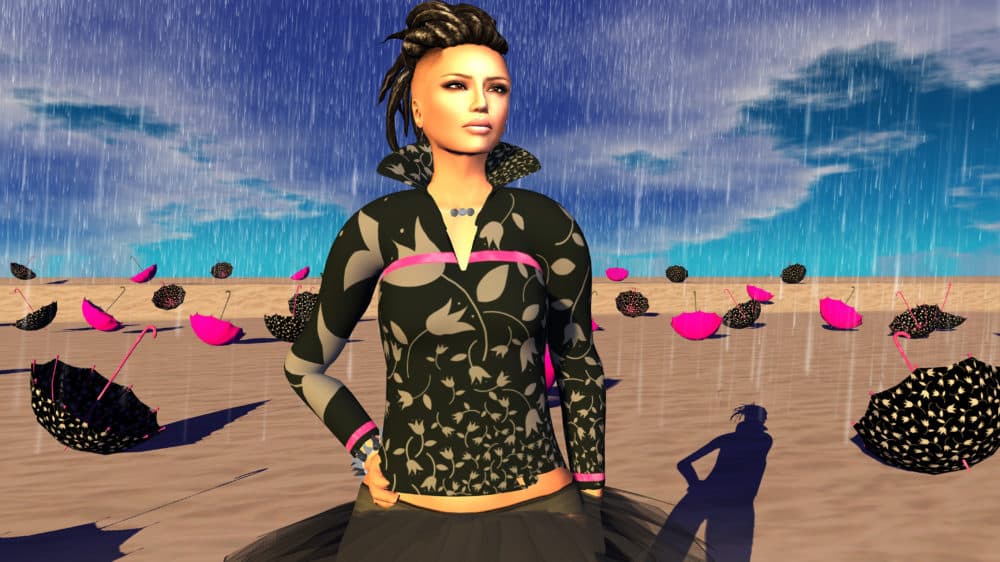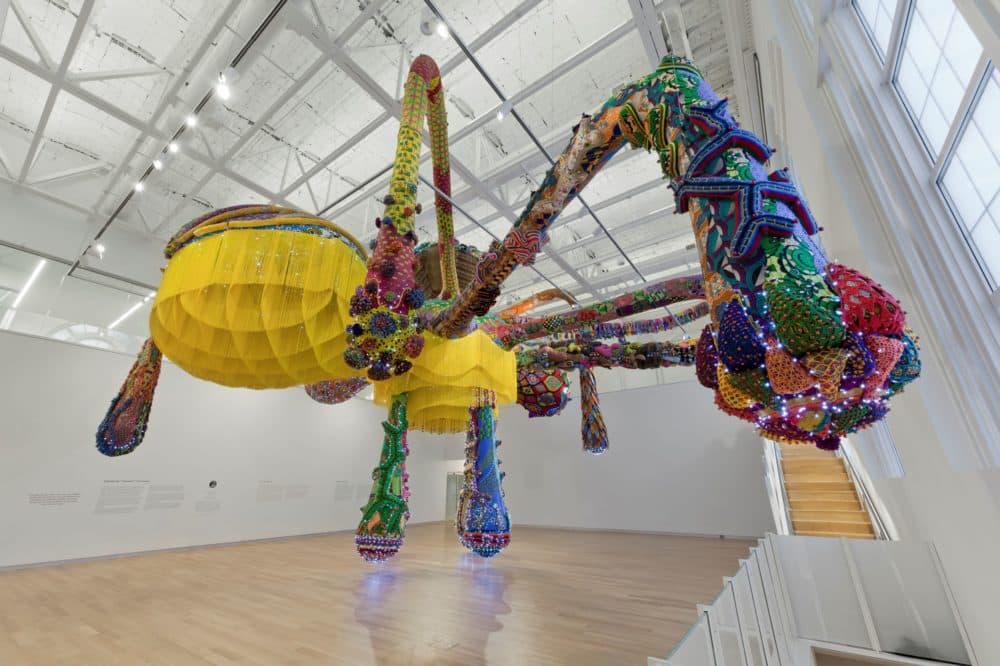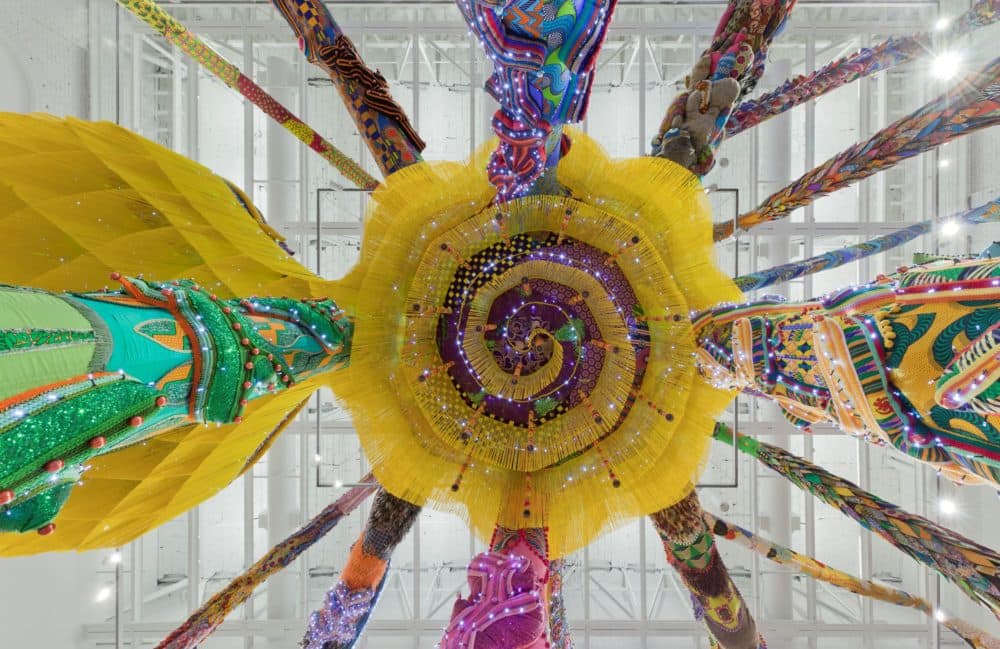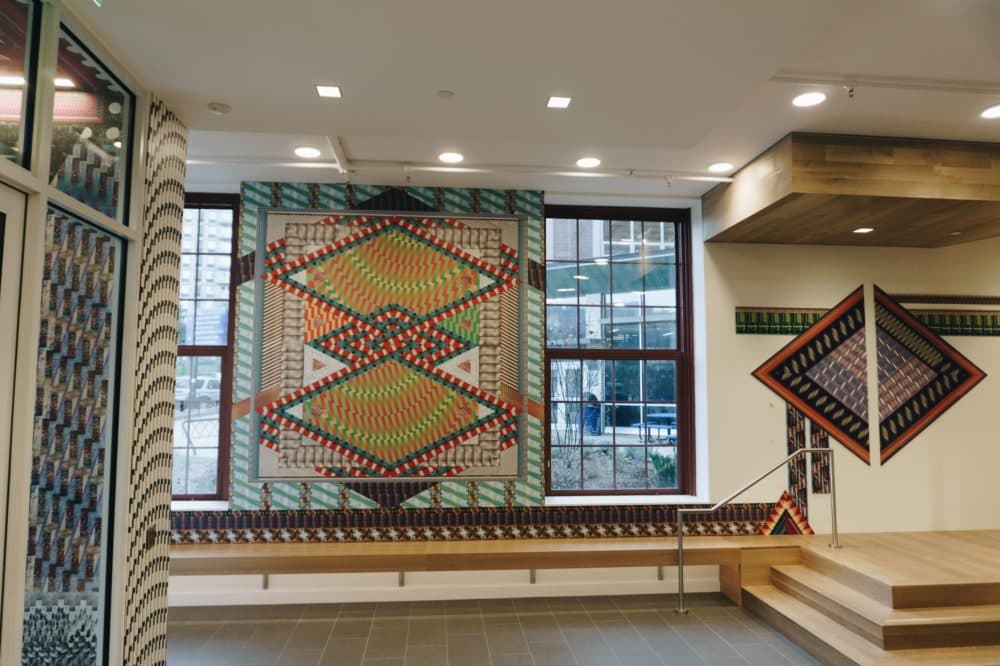Advertisement
Review
At MassArt Art Museum, Artists Examine Racial And Gender Systems

Nice to meet you, MAAM.
MassArt Art Museum’s moniker, MAAM, is a name that I like to think intentionally plays on “ma’am,” given the feminist curatorial approach of its inaugural shows. “Valkyrie Mumbet,” “Game Changers” and “Yesterday is Here” include strong woman-identifying representation and contend with traditionally-femininized themes and materials, yes. But more than these surface gestures towards gender equality, MAAM’s first shows each deal with systems and networks as feminist aesthetics.
Museums as spaces for connection seems to be MAAM’s organizing principle.
Not only do its first exhibitions engage with the nature of systems and relationships, they also literally offer spaces to meet. (It seems quite intentional that each show includes ample seating.) MAAM’s first shows succeed most successfully when a framework for this is presented in a focused, yet expansive way, as in the show-stopping installation upstairs, or in a much subtler one along the museum’s stairs.

For instance, Joana Vasconcelos’ “Valkyrie Mumbet” is a mammoth yet meditative sculpture that makes room for people to walk under and around it. Sprawling and immersive, this vibrant octopus-like sculpture hangs from the ceiling. Belying its mass is its makeup of human-scaled handcrafted details — from crocheted swatches, to sequined roots, to golden beads and white lights — bringing viewers in closer for a more intimate examination. It’s a smart tension between macro and micro that parallels the work’s reflections on webs of knowledge.
The handicrafts composing the piece are literal networks, but historically, they are also the means by which generations of women and other oppressed peoples shared knowledge. The trafficking of goods, knowledge and, most significantly, human bodies from the Colonial period onwards is a subject the Portuguese Vasconcelos fully embraced in “Valkyrie Mumbet,” her first solo U.S. presentation. Each of her sculpture’s 22 tendrils features different textiles mined from her vast collection of global fabrics, mapping in space how craft traditions migrate along trade routes. Notably, one tendril is dotted by patterned Mozambican capulanas. A country only 55 years free from Portuguese colonial rule, Mozambique is where Vasconcelos’s parents grew up. The inclusion of capulanas, as well as that of colorful African wax cloth, seems to be her delicate recognition of her relationship to the violence of slave trades and other colonial enterprises.

Vasconcelos makes most explicit Massachusetts’s connection to chattel slavery in our own Colonial period, as well as our need to recognize the black women who subverted that brutal system through craft traditions. “Valkyrie Mumbet” is inspired by Elizabeth “Mumbet” Freeman, the first African American woman self-liberated from slavery through the court system. But, like those of many black women in America, her story has been obscured for centuries, even as those narratives of middle- and upper-class white women were elevated by first- and second-wave feminism.
“Valkyrie Mumbet” is the latest in the artist’s series of sculptures inspired by Norse mythology dedicated to influential women, goddesses and heroines. By inserting Mumbet’s story into this system of knowledge — mythology — Vasconcelos accentuates how stories can be told collectively rather than individually.
MAAM seems eager to invite its surrounding communities to contemplate Mumbet’s lived experience and legacy through conversation; programs are being developed, including a talk led by The 1619 Project from The New York Times Magazine. Vasconcelos’s hyperbolic aesthetic is not for everyone, but there is something for everyone in this work. This spider-like sculpture embodies a communal web extended to others to add and reflect, which is the inverse of the top-down, hierarchical ways in which histories are typically told.

Collective storytelling is more ambiguously considered in “Game Changers,” a group show of artists working with gaming or digital interfaces. The nine artists included hail from countries typically under- or misrepresented in encyclopedic museum collections, an incorporation that implies a “game change,” but this hinted revisionist gesture ends there. In “Game Changers,” artists are literally manipulating networks, codes or other systems to expand narratives, complicate identities or imagine alternate realities. But the exhibit doesn’t focus enough to allow for expansive thinking on any one aspect of the many themes presented.
The visual din of so many screens, sculptural elements and supporting props oversaturates the space (perhaps an intentional nod to the internet in general?). The show’s focal point seems to be Tracy Fullerton’s “Walden, A Game” (2017), in which she takes Thoreau’s influential text and recreates it as a game, the prize of which is the stillness the Transcendentalist advocated. Walden, as Thoreau described it in his book, is digitally recreated in the game and also replicated in the gallery space in distracting, kitschy physical form through fall-colored silk leaves, real pinecones and decorative camping lanterns. Digital and physical worlds collide more purposefully, fusing the past with alternative futures, in multimedia artist Skawennati’s installation of video and machinima alongside the beaded “Intergalactic Empowerment Wampum Belt” (2020).
We’re clumsily invited to play many of these games, save for Juan Obando’s “Pro Revolution Soccer” (2019), which is seamlessly installed as if it were in a Best Buy electronics store. On opening day, people naturally picked up a controller to play, making his adjacent “The Other Campaign” (2019), in which he translates Zapatista Army of National Liberation (EZLN) slogans over images from the game, an all the more provocative examination on how myths are made.

MAAM isn’t without a history: the collaborative duo Ghost of a Dream remind us of this with their entryway and staircase installation, “Yesterday is Here” (2019). A patterned remix of 30 years of the predecessors to MAAM — the Bakalar & Paine Galleries — ephemera (think catalogs, announcements, posters), this ascending work uses the craft languages of mosaic or quilt-making to link “Game Changers” and “Valkyrie Mumbet.”
Like all of MAAM’s inaugural program, it’s less a vertical connection point than a web of stories and histories.
"Yesterday is Here" is on view through Feb. 28, 2021, "Valkyrie Mumbet" through Aug. 2 and "Game Changers" through April 19 at MAAM.
Leah Triplett Harrington is a writer, curator and editor. She’s the founding editor of The Rib and the assistant curator of Now + There.